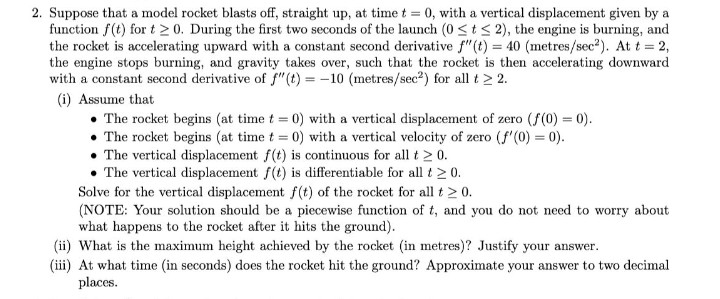2. Suppose that a model rocket blasts off, straight up, at time t = 0, with a vertical displacement given by a function f(t) for t 2 0. During the first two seconds of the launch (0
2. Suppose that a model rocket blasts off, straight up, at time t = 0, with a vertical displacement given by a function f(t) for t 2 0. During the first two seconds of the launch (0
Algebra & Trigonometry with Analytic Geometry
13th Edition
ISBN:9781133382119
Author:Swokowski
Publisher:Swokowski
Chapter4: Polynomial And Rational Functions
Section: Chapter Questions
Problem 5T
Related questions
Question
100%
Solve all parts kindly and solve this perfectly in 2 to 3 hours only plz don't take too much time and take a thumb up

Transcribed Image Text:2. Suppose that a model rocket blasts off, straight up, at time t = 0, with a vertical displacement given by a
function f(t) for t 2 0. During the first two seconds of the launch (0 <t < 2), the engine is burning, and
the rocket is accelerating upward with a constant second derivative f"(t) = 40 (metres/sec²). At t = 2,
the engine stops burning, and gravity takes over, such that the rocket is then accelerating downward
with a constant second derivative of f"(t) = -10 (metres/sec2) for all t > 2.
(i) Assume that
The rocket begins (at time t = 0) with a vertical displacement of zero (f(0) = 0).
• The rocket begins (at time t = 0) with a vertical velocity of zero (f'(0) = 0).
• The vertical displacement f(t) is continuous for all t > 0.
• The vertical displacement f(t) is differentiable for all t 2 0.
Solve for the vertical displacement f(t) of the rocket for all t > 0.
(NOTE: Your solution should be a piecewise function of t, and you do not need to worry about
what happens to the rocket after it hits the ground).
(ii) What is the maximum height achieved by the rocket (in metres)? Justify your answer.
(iii) At what time (in seconds) does the rocket hit the ground? Approximate your answer to two decimal
places.
Expert Solution
This question has been solved!
Explore an expertly crafted, step-by-step solution for a thorough understanding of key concepts.
This is a popular solution!
Trending now
This is a popular solution!
Step by step
Solved in 3 steps

Recommended textbooks for you

Algebra & Trigonometry with Analytic Geometry
Algebra
ISBN:
9781133382119
Author:
Swokowski
Publisher:
Cengage

Algebra & Trigonometry with Analytic Geometry
Algebra
ISBN:
9781133382119
Author:
Swokowski
Publisher:
Cengage